Bernard Breiter and the B-24 "Lil' Audrey"
Hickam Airfield, Hawaii

The Pouls crew was sent to Hickam Airbase, Oahu, Hawaii in February 1944, where it became part of the 11th Bomb Group, 431st Squadron.
The crew apparently trained on other parts of the island as well. The Army Air Forces used Wheeler Airfield and Kahuku Army Airfield on Oahu's North Shore during this period. Barney's letters were censored from this point.
Nicknamed the "Grey Geese", the 11th's motto was: "One damned island after another".
Before 1944, the 11th Bomb Group was part of the 13th Army, and flew the B-17.
Now they would all train on the replacement Consolidated B-24J bomber, through at least April 1944.
"The B-24D was sadly lacking in firepower, particularly in the nose of the plane. Japanese pilots soon discovered this defensive weakness, with the result that General Landon reported that approximately half of all early enemy fighter attacks on B-24's were made frontally. After Lt. Col. Marion D. Unruh, of the VII Bomber Command, had designed a nose turret to correct the weakness, it was installed by the Hawaiin Air Depot in more than 200 B-24s during 1943. B-24 firepower was further improved by the installation of twin .50 cal. machine guns in the belly and tail of the airplane. The depot also moved the navigator's position to the flight deck and developed pilot and co-pilot blister windows to provide greater visibility. It continued to perform these modifications for the Pacific theaters until the advent of the B-24J, which included most of the changes."
from "The Army Air Forces in WWII: Vol. IV"
The crew apparently trained on other parts of the island as well. The Army Air Forces used Wheeler Airfield and Kahuku Army Airfield on Oahu's North Shore during this period. Barney's letters were censored from this point.
Nicknamed the "Grey Geese", the 11th's motto was: "One damned island after another".
Before 1944, the 11th Bomb Group was part of the 13th Army, and flew the B-17.
Now they would all train on the replacement Consolidated B-24J bomber, through at least April 1944.
"The B-24D was sadly lacking in firepower, particularly in the nose of the plane. Japanese pilots soon discovered this defensive weakness, with the result that General Landon reported that approximately half of all early enemy fighter attacks on B-24's were made frontally. After Lt. Col. Marion D. Unruh, of the VII Bomber Command, had designed a nose turret to correct the weakness, it was installed by the Hawaiin Air Depot in more than 200 B-24s during 1943. B-24 firepower was further improved by the installation of twin .50 cal. machine guns in the belly and tail of the airplane. The depot also moved the navigator's position to the flight deck and developed pilot and co-pilot blister windows to provide greater visibility. It continued to perform these modifications for the Pacific theaters until the advent of the B-24J, which included most of the changes."
from "The Army Air Forces in WWII: Vol. IV"
The Pacific Island Campaign
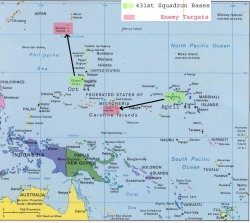
As the Americans pushed West and North through the Pacific (with their sights ultimately on mainland Japan), so did the 11th Bombardment Group.
They bombed airfields, supply dumps, ships, docks and troop positions.
In April 1944 the 11th moved onto Kwajalein to attack islands in the Marshall and Marianas Island chains.
Barney's group likely arrived in June/July.
"By D-day (June '44) on Kwajalein, there was not an operational Japanese aircraft east of Eniwetok. Throughout the operation the U.S. Navy dominated the air over the Gilberts and Marshalls. The planes of the Seventh Air Force, flying long overwater missions, maintained the neutralization of bases initially knocked out by planes from the fast carriers. Continued bombardment from the air reduced the by-passed atolls to impotence; their garrisons, cut off even from communication with other positions, were occupied in a struggle merely to keep alive."
from AAF in WWII Vol. IV
They bombed airfields, supply dumps, ships, docks and troop positions.
In April 1944 the 11th moved onto Kwajalein to attack islands in the Marshall and Marianas Island chains.
Barney's group likely arrived in June/July.
"By D-day (June '44) on Kwajalein, there was not an operational Japanese aircraft east of Eniwetok. Throughout the operation the U.S. Navy dominated the air over the Gilberts and Marshalls. The planes of the Seventh Air Force, flying long overwater missions, maintained the neutralization of bases initially knocked out by planes from the fast carriers. Continued bombardment from the air reduced the by-passed atolls to impotence; their garrisons, cut off even from communication with other positions, were occupied in a struggle merely to keep alive."
from AAF in WWII Vol. IV
Kwajalein Island - Marshall Islands
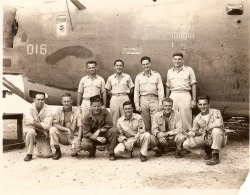
"The plane's second crew flew their first mission to Truk from Kwajalein on July 4, 1944. They said they realized little of what was happening. They flew in, released their bombs on the signal from the lead plane, and got out. "It was like a dream," they reported, "not something real." The next 17 missions were over Truk and the crew grew battle-wise." from Grey Geese Calling
Taken on the island of Kwajalein, October 1944.
Donald G. Hallman/Tailgunner was added about this time.
Officers standing L-R: Bernard J. Breiter/Co-Pilot, Thomas G. Page/Navigator, Francis Pouls/Pilot, Stephen G. Coffey/Bombardier.
Crew crouching L-R: Donald G. Hallman/Tailgunner, Harold Kilpatrick/Assistant Engineer, Richard W. Martin/Waistgunner, Lloyd J. Rainbolt/Engineer, unknown, Alex C. Shinsky/Radio,Top Turret Gunner.
Plane lacks nose art. Note the name PAGE, for navigator Tommy Page's position on the plane.
Taken on the island of Kwajalein, October 1944.
Donald G. Hallman/Tailgunner was added about this time.
Officers standing L-R: Bernard J. Breiter/Co-Pilot, Thomas G. Page/Navigator, Francis Pouls/Pilot, Stephen G. Coffey/Bombardier.
Crew crouching L-R: Donald G. Hallman/Tailgunner, Harold Kilpatrick/Assistant Engineer, Richard W. Martin/Waistgunner, Lloyd J. Rainbolt/Engineer, unknown, Alex C. Shinsky/Radio,Top Turret Gunner.
Plane lacks nose art. Note the name PAGE, for navigator Tommy Page's position on the plane.
Co-pilot's Logbook

The Pouls crew was assigned to Lil' Audrey (B24J-C.O.-2, 42-73016) which already had a reputation of being lucky and bringing its men home in one piece. She was hit by enemy flak more than 75 times, but never lost a crew member.
Barney was later referred to as "Lucky" by some of his comrades.
Barney's logbook details the flight order for each mission.
The last 3-digits number of the plane and the pilot's last name. Lil' Audrey (Pouls) is #016.
A different "Lifeguard" aircraft was designated for each mission - "Long Legs" in this case.
On this July 28th, 1944 mission over the Truk Islands, North Moen Island, the crew of Lieutenant Ralph Max was shot down.
Barney was later referred to as "Lucky" by some of his comrades.
Barney's logbook details the flight order for each mission.
The last 3-digits number of the plane and the pilot's last name. Lil' Audrey (Pouls) is #016.
A different "Lifeguard" aircraft was designated for each mission - "Long Legs" in this case.
On this July 28th, 1944 mission over the Truk Islands, North Moen Island, the crew of Lieutenant Ralph Max was shot down.
Caroline Island Chain, Truk Islands, Eten Island Airfield

On a September 10th - 11th mission, the Pouls crew is second up. Gunner William Gannon was credited with downing one Japanese Zero on this mission over the air installations in the Truk Islands (Eten Island).
"Sept. 11 - Eten airfield, for the first time this month, felt the wrath of approximately 30 tons of bombs dropped by nine planes from the 431st in joint action with five aircraft from the 98th. S/Sgt. William B. Gannon, nose turret gunner on Lt. Pouls' plane, destroyed one of the five or six Jap interceptors. S/Sgt. Joseph L. Field, top turret gunner on Capt. Crampton's plane was credited with damaging a Zeke. Piloting 431st planes were Coates, Pouls, Crampton, Murray, Sheppard, Spence, Hodson, Honeyman and Lundy." from Grey Geese Calling
Eten Island Anchorage/Airfield, Truk Islands
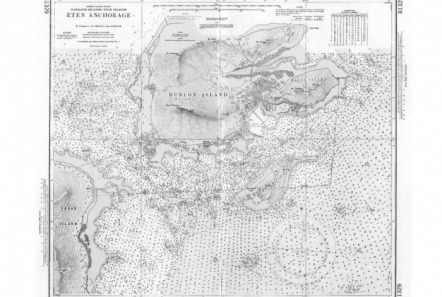
86 Missions
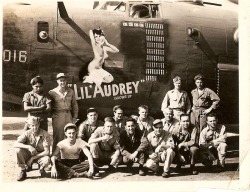
In October 1944 it moved to Guam, attacking targets in the Volcano (Iwo Jima included) and Bonin Islands.
"Lil' Audrey Grows Up" and her crew with 86 missions complete (note the number of bombs and the name POULS near the window).
Four Japanese flags are likely the kills credited to this aircraft.
Location likely Depot Field, Guam
"Lil' Audrey began her career in the days when combat planes were camoflaged in olive drab. Her warpaint flaked and burned by exhaust flames, she stood out in contrast to the gleaming newer Liberators at her base in the Marianas. Her patches showed and it was admitted that she creaked a little and required extra attention on the ground and in flight." "As evidence of her endurance, Lil' Audrey flew her 95th mission to Iwo Jima just four hours after she landed from her 94th, putting in 20 hours of flying time within 24." from Grey Geese Calling
"Lil' Audrey Grows Up" and her crew with 86 missions complete (note the number of bombs and the name POULS near the window).
Four Japanese flags are likely the kills credited to this aircraft.
Location likely Depot Field, Guam
"Lil' Audrey began her career in the days when combat planes were camoflaged in olive drab. Her warpaint flaked and burned by exhaust flames, she stood out in contrast to the gleaming newer Liberators at her base in the Marianas. Her patches showed and it was admitted that she creaked a little and required extra attention on the ground and in flight." "As evidence of her endurance, Lil' Audrey flew her 95th mission to Iwo Jima just four hours after she landed from her 94th, putting in 20 hours of flying time within 24." from Grey Geese Calling
"The Crash Landing" by Lloyd Rainbolt (Engineer)
As for the time we were shot up so bad over target, we received a large burst of flak in the bomb bay before we had dropped our bombs. We had pulled the pins out of the bombs so if any were hit on the nose they would explode. We had 2,000 pounds in the bomb bay, or four 500 pound bombs, as I recall. I'll never know how all the pieces of steel hitting the bombs didn't explode one or all of them. The men in the back of the plane called that they were being covered by something and couldn't see as it covered the lens of their flying glasses. By this time we had the bombs dropped out and I was in the bomb bay looking at the damage. Everything was red and so slick that I could hardly stand on the "cat walk" narrow track through the bomb bay. I found the main hydraulic line from the reservoir to the #3 engine had been blown away by the flak. The #3 engine was our main engine as it had the only hydraulic pump for all the airplane's brakes, landing gears, and many other things. It looked like our luck had run out and we would have to crash land. We had about five hours flying to get home so I searched the plane over, but I couldn't find any piece of tube or piple I could use to patch the lines. At last I managed to get the repair made but I knew that at best it would be a one shot deal. With the help of the crew I cranked the landing gears down, and did everything I could think of, manually. We tied parachutes to the gun mounts at each waist window and one in the tail end of the plane. Each man stood by to pull the cord if the pilot gave the order. As we came around to land all the emergency vehicles were waiting. Here is where the grapefruit juice came in. I had to have something to pour into the tank, to go to the pump on the engine, to build pressure for the brakes. I located about two gallons of juice to use and as we approached the runway I poured the juice in and up came the hydraulic pressure just enough to use the brakes one time. This account you will find in the 7th Air Force records more than one time. It took several days to get the juice out of the lines as it would freeze at high altitudes, but no one complained because we got back with only one man wounded. The navigator was hit over the target by flak, but he never missed a mission. I might add that I never heard a bad word from him or the co-pilot all the time I was with them. Another thing I remember, was that on this trip and a few others, while were were over the target on extra rough missions, I would find large drops of sweat frozen solid around my oxygen mask. I didn't even realize I was sweating at below zero temperature. from 11th Bomb Group (H) The Grey Geese Turner Publishing
Barney would write in a letter a similar account (one significant difference was whether the bombs had left the bomb bay when the plane was hit)
to his niece Sharon more than 40 years later:
"I had nothing to do with trying to fix the hydraulic reservoir. I was flying at the time. The flack burst off in front and slightly below the plane. Close enough so you could see the flash of flame. It usually appears like a black puff of smoke. Anyway a piece of flak hit to the right of the bombardier went through a couple of bulkheads and hit the tank. I think if the bombs had still been in the bomb bay there's no telling what would have happened. The bombardier always had trouble opening the bomb bay doors from up front - so Tom Page (navigator) stepped down from the flight deck (just in front of the bomb bay) and opened them from there. Because he was standing there when the piece of flak tore through those bulkheads he got pieces stuck in his behind but didn't tell anybody about it until later. He didn't want a purple heart for it but got it anyway. The story about gun oil and water to replace hydraulic fluid, I don't know about the gun oil. I heard it was fruit juice they used. Anyway - I was able to pump down the flaps and the brake system had accumulated with about 2000 lbs of pressure so were were able to stop the plane. Simply left it on the taxiway. During the night the ground crew (assistant crew chief was along) had to wash out the entire hydraulic system to get everything out they put in. They also changed the right main tire and the nosewheel which had a piece of aluminum sticking in the tire. Anyway the hydraulic shystem worked after that so the whole thing was forgotten.
Barney would write in a letter a similar account (one significant difference was whether the bombs had left the bomb bay when the plane was hit)
to his niece Sharon more than 40 years later:
"I had nothing to do with trying to fix the hydraulic reservoir. I was flying at the time. The flack burst off in front and slightly below the plane. Close enough so you could see the flash of flame. It usually appears like a black puff of smoke. Anyway a piece of flak hit to the right of the bombardier went through a couple of bulkheads and hit the tank. I think if the bombs had still been in the bomb bay there's no telling what would have happened. The bombardier always had trouble opening the bomb bay doors from up front - so Tom Page (navigator) stepped down from the flight deck (just in front of the bomb bay) and opened them from there. Because he was standing there when the piece of flak tore through those bulkheads he got pieces stuck in his behind but didn't tell anybody about it until later. He didn't want a purple heart for it but got it anyway. The story about gun oil and water to replace hydraulic fluid, I don't know about the gun oil. I heard it was fruit juice they used. Anyway - I was able to pump down the flaps and the brake system had accumulated with about 2000 lbs of pressure so were were able to stop the plane. Simply left it on the taxiway. During the night the ground crew (assistant crew chief was along) had to wash out the entire hydraulic system to get everything out they put in. They also changed the right main tire and the nosewheel which had a piece of aluminum sticking in the tire. Anyway the hydraulic shystem worked after that so the whole thing was forgotten.

On the home front: Paul Gregg, Jim Breiter, Lowell Palm and Sharon Palm
A 7th AAF Heavy Bomber Base in the Marianas
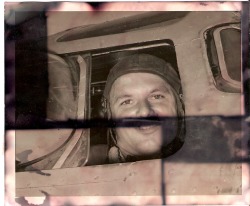
"Second Lieutenant Bernard J. Breiter, son of Mr. and Mrs. Herman Breiter Sr., Church Road, Bensenville, Illinois, looks out from his co-pilot seat in the veteran 7th AAF Liberator bomber, "Lil' Audry," at an advanced base in the Marianas shortly before completing his 40-mission tour of duty. A farmer in civilian life, the 26-year old co-pilot entered the service in March, 1942, won his wings in February, 1943, and has been overseas since January, 1944. He holds the Air Medal with an Oak Leaf Cluster and the Distinguished Flying Cross. (AAF Pacific Photo)
Public Relations Office Pacific Headquarters Army Air Forces
Public Relations Office Pacific Headquarters Army Air Forces
